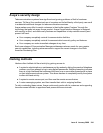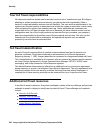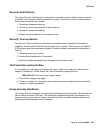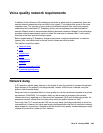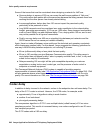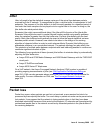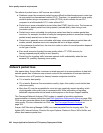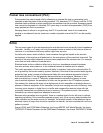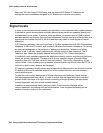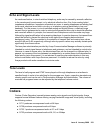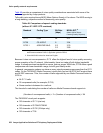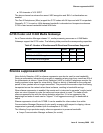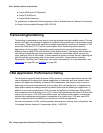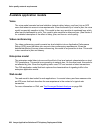
Echo
Issue 6 January 2008 249
Packet loss concealment (PLC)
Some packet loss can be dealt with by attempting to conceal the loss by generating voice
samples to take the place of the missing samples. ITU standards G.711 Annex I and the G.729
standard define methods by which packet loss concealment can be provided. Excessive packet
loss cannot be disguised so, ultimately, PLC gives way to comfort noise generation (CNG) if too
many packets are lost in succession.
Ramping down to silence is a typical way that PLC is performed. Loss of six consecutive
packets is considered to be the maximum number of packets over which PLC can be sensibly
applied.
Echo
The two main types of echo are acoustic echo and electrical echo caused by hybrid impedance
mismatch. Usually, in a 2-party call, only the speaker hears an echo but the receiver does not.
However, in a conference call many parties might hear an echo.
Acoustic echo occurs when a talker’s voice traverses through the airpath in the acoustic
environment of the receiver and feeds back to the microphone of the rereceiver’s terminal. The
severity of the echo effect depends on the acoustic properties of the remote room. For example,
room size and wall reflection characteristics.
Electrical echo is also a reflection effect but is due to an impedance mismatch between
four-wire and two wire systems or in the interface between a headset and its adapter.
The user's perception of echo increases with delay. In practice, most echo received within 30
ms is ignored by the human auditory system. However, if the level of the received echo signal is
extremely high, even a couple of milliseconds delay will cause adverse perception of echo.
Echo received after 30 ms will generally be perceived as an annoyance. Because of the
end-to-end latency in some IP Telephony implementations exceeds the latency in some
circuit-switched systems, the perception of echo can be greater in the IP Telephony system.
One strategy for dealing with echo is the deployment of echo cancellers at strategic places in
phones or network equipment. Echo cancellers, which have varying amounts of memory, store
incoming voice streams in digital form in a buffer and compare the received voice with the
previously transmitted voice patterns stored in memory. If the patterns match, the canceller
considers it an echoed signal and attempts to remove it.
Because echo cancellers are not perfect, there is a residual level of echo left even in optimal
operating conditions. Echo cancellers operate properly only if the one-way delay between the
echo canceller and the echo source (for example, the acoustic airpath at the telephone set or
electrical hybrid) is larger than the echo canceller can handle, the echo canceller will not find a
pattern to cancel.
Avaya's G350 and G700 Media Gateways, the Avaya MM760 VoIP Media Module, the Avaya
TN2302AP IP Media Processor (in the G650 Media Gateways), the Avaya TN2602AP IP Media



